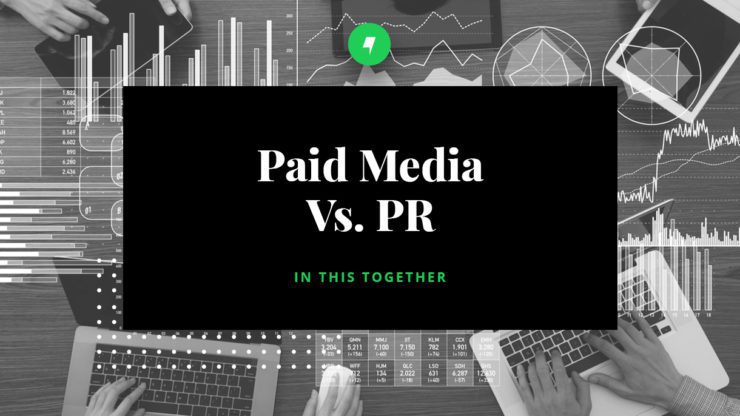Comparing two different media strategies.
Paid media and public relations, despite being individually strong, are frequently used in tandem to achieve a company’s or individual’s marketing objectives. These two approaches hold the capacity to communicate with a target audience, establish brand visibility, and inspire a desired change of action.
Let’s look at the differentiating aspects of paid media vs. public relations and how they work together.
Definitions & Examples
Paid media is defined as a one-way communication channel used to promote a concept, product, or service. Examples of this strategy can include boosted social media ads, website banners, and ad placements within print publications. Paid media is intended to reach a chosen audience while allowing the brand to maintain complete control over the product.
In contrast, PR, also referred to as “earned media”, requires the work of employing pitches or press releases to “earn” notice in a newspaper, magazine, blog, TV segment, and so on. Earned media today can encompass guest blog posts, social media promotion, inclusion in a news or trend story, and even elements of SEO. To gain visibility with the intended audience, a PR practitioner must convince outlets that the story, service, or product is relevant to their reader or viewership and worth sharing.
Levels of Control
In a paid media strategy, the brand controls the message, where it appears, and how frequently it appears. With this control in the hands of the brand, the tone of the narrative will always be consistent with that of what is intended for the audience.
Clients working through a PR approach can control the channels in which they seek exposure, but not necessarily the content itself. A pitch or press release can be prepared and drafted with a company’s key message and other relevant information, but once submitted, the end product ultimately lies with the publication or outlet.
Cost
With no surprise, paid media is expensive. Costs can include ad space, creative design, timing of coverage, and the cost to boost specific posts and ads for maximum reach. Most paid media campaigns are done within a defined time frame.
There is still a cost for PR, however, it is with the agency or individual you’re paying to garner the coverage, and not for the coverage itself.
Credibility
When attempting to reach a target audience, the challenge of having to establish credibility and trust presents itself. PR, or messages from third parties, typically hold more credibility for an audience than messages from the brand itself (a.ka. paid media). With a valued publication or news outlet delivering your story and thus giving it legitimacy, PR can be a more effective tool for building credibility.
In This Together
PR and paid media have the same priorities, but they achieve their results in different ways. Both approaches attempt to influence and increase awareness among a specific audience. While each possesses its own advantages and disadvantages, they are often used together for maximum impact. A media relations team, for example, may write a press release to send to hyperlocal sources covering a specific area, but they can’t ensure the story would be picked up. To broaden the reach and chances of publicity for this release, the team might also send messaging through paid media—such as geotargeted social media ads.
Together, paid media and PR produce a comprehensive, effective, and wide-reaching awareness campaign by expanding audience reach and brand recognition.
For more on the elements of a successful PR strategy, read Jessica Sharp’s ‘Why Your PR Campaign Needs a Strategy.’
Posted In Media Relations
